Specification Design Pattern
Allow a Client to select or filter objects with specific attribute property values as specified by the Client.

Introduction
The Specification Design Pattern is the next of the Composable Design Patterns series. It does not reside within the Gang of Four’s (GoF) Design Pattern catalog.
The Specification Design Pattern allows a Client to identify objects via an attribute value based specification defined by the Client. The attribute specification can be simple or complex. There are several use case scenarios featuring specifications, such as:
- Selects specification satisfying objects from a repository.
- Filters specification satisfying objects within an iterator. This is similar to the above.
- Filters specification satisfying objects in a stream. Also similar to the above.
- Requests notifications for specification satisfying object subscriptions. For example, subscribe to an object and request notifications only when one of its attributes crosses a threshold value.
- Defines specification satisfying alert criteria, which is similar to the above as well.
Specification is similar to the select or query feature in databases. The main distinction is that the objects being considered within Specification are objects and not records in a database.
The Specification Design Pattern will feature several previous design patterns:
- Strategy resides at its core, but then again, Strategy resides at the core of many design patterns we’ve reviewed so far.
- Composite will extend the ability of the Client to construct complex Specifications, since Strategy on its own will only be able to construct simple Specifications.
- Template Method will be used for Specification management.
- And we’ll see Dependency Injection as well, but it will be a little different than before. Previous design patterns featured a Configurer who created objects organized in a design pattern structure and injected them into the Client. In Specification, Clients create their own Specifications and inject them into the pattern at any time.
Real World Analogies to Specification
Like the previous composable design patterns, Specification is not difficult to implement. It’s an extension of Composite. Its main challenge is comprehension. Here are a few real-world examples to ease one into the Specification concept.
Matchmaker, Matchmaker, Make Me a Match
The musical Fiddler on the Roof features the song Matchmaker sung by Tevye’s three oldest daughters speculating upon whom the local matchmaker might find for their husbands.

Here are several lyrics:
Matchmaker, Matchmaker,
Make me a match,
Find me a find,
Catch me a catch
Matchmaker, Matchmaker
Look through your book,
And make me a perfect match
Matchmaker, Matchmaker,
I’ll bring the veil,
You bring the groom,
Slender and pale.
Bring me a ring for I’m longing to be,
The envy of all I see.
For Papa,
Make him a scholar.
For mama,
Make him rich as a king.
For me, well,
I wouldn’t holler
If he were as handsome as anything.
The lyrics define the specification: (build==slender AND complexion==pale AND education==scholar AND wealth==rich) OR (looks==handsome). They want the Matchmaker to look through her list for a groom for those who match this specification. While not in the lyrics, should a new potential groom match the specification, then they would like to be notified as well.
Collectors
The TV show American Pickers featured antique collectors Mike and Frank driving around rural American looking for trash that they could convert into treasures and sell at their antique store in the Midwest.

The show focused upon the interesting characters they encountered on the road, the items these characters had collected, and Mike and Frank negotiating a price.
These collections often look like a hoarder’s stash stored in a leaning barn about to topple over. Several times the guys would launch themselves onto unstable filth looking for that diamond in the rough. I’m sure they had to keep their tetanus shots up to date.
The treasures they’d find tended to be antique toys, car parts, motorcycle parts, old gas station signs, etc. The collectors often had detailed knowledge of anything pulled from the piles. They could often remember when and where they acquired something and how much they paid for it.
Quite frankly most of the items Mike and Frank gushed over just looked like junk to me. But they knew the specifications for what their customers wanted and what they’d be willing to pay for them.
Google Searches and Alerts, especially Jobs
Most online search engines are a form of Specification. Your search query is a specification, and the search engine will find and return pages that best match that specification. Google will allow you to create an alert for that specification query so that it will send you an email when it finds additional pages that match that specification.
Google’s Job UI/UX is even closer to Specification. Go to: https://www.google.com/search?q=jobs and click on the Jobs banner at the top.
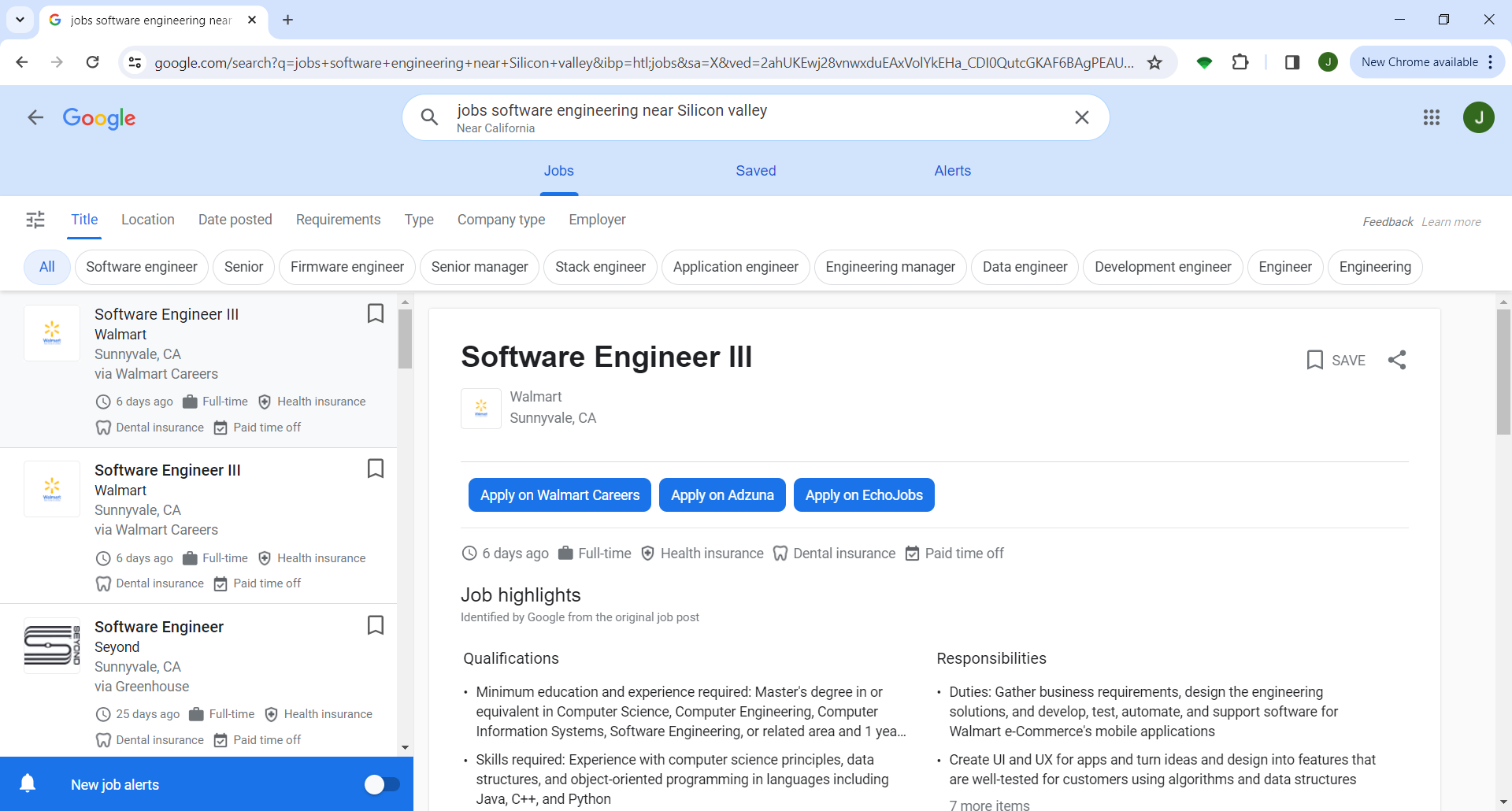
This is a Google Jobs portal that will let anyone define a Job Specification based upon job title, location, full/part time, keywords, etc. as shown in the provided image. The Specification can be fine-tuned as much as needed, and Google will refresh the job list upon each update. Once you have a Job Specification you like, you can save it as an Alert so that Google will send you an email when it finds new jobs that match your Specification.
Each job searcher can customize his or her own Job Specification. And job searchers are not limited to just one Specification. They can create different Specifications with different criteria.
Design Structure
Specification is an extension of Composite, but with a few enhancements. We have a few steps before we get there.
Problem Description
We have a Client who is interested in a selection of Context objects based upon a Specification defined by the Client. The Specification is passed to a ContextManager which will return those Context objects that satisfy the Specification.
That description was awful. Let me match the Problem Description terms using the examples above:
| Problem Description | Matchmaker | Antiques | Google Jobs |
|---|---|---|---|
| Client | Young Woman | Customers back at the shop | A person looking for a job |
| ContextManager | Matchmaker | Mike and Frank | |
| Context | Husband Candidate | Antique/Collector Item residing in a leaning barn | An online Job opening |
| Specification | (build==slender AND complexion==pale AND education==scholar AND wealth==rich) OR (looks==handsome) |
Items their customers are interested in | Job location, title, salary, etc. |
Here’s a UML class diagram for this behavior:
- At this level of abstraction, the diagram only shows the
Specificationinterface.Specificationdetails will be provided shortly.Specificationdeclares one method that will return a boolean indicating whether theContextsatisfies theSpecification. - The
Clienthas a reference toContextManager, which was probably injected into it. If I had more space, I’d have shown an interface for theContextManagerandClientwould have had a reference to the interface probably resolved by aConfigurer. - The
Clientacquires aSpecificationreference. Details coming soon. - The
ClientcallsContextManager’sgetContextsBy(Specification specification), which will return the list ofContextobjects that satisfy theSpecification. We can viewspecificationas an argument being passed in, but I like to think of it as a form of Dependency Injection.ContextManagerdepends upon aSpecificationfor each method call. ContextManagercontains a List ofContextobjects. Its method iterates that List and adds aContextto the list ofsatisfiedContextswhen aContextobject satisfies the injectedSpecification. TheContextManagerhas no knowledge of or dependency upon theSpecificationimplementation. Its only concern is interacting with the contract interface.
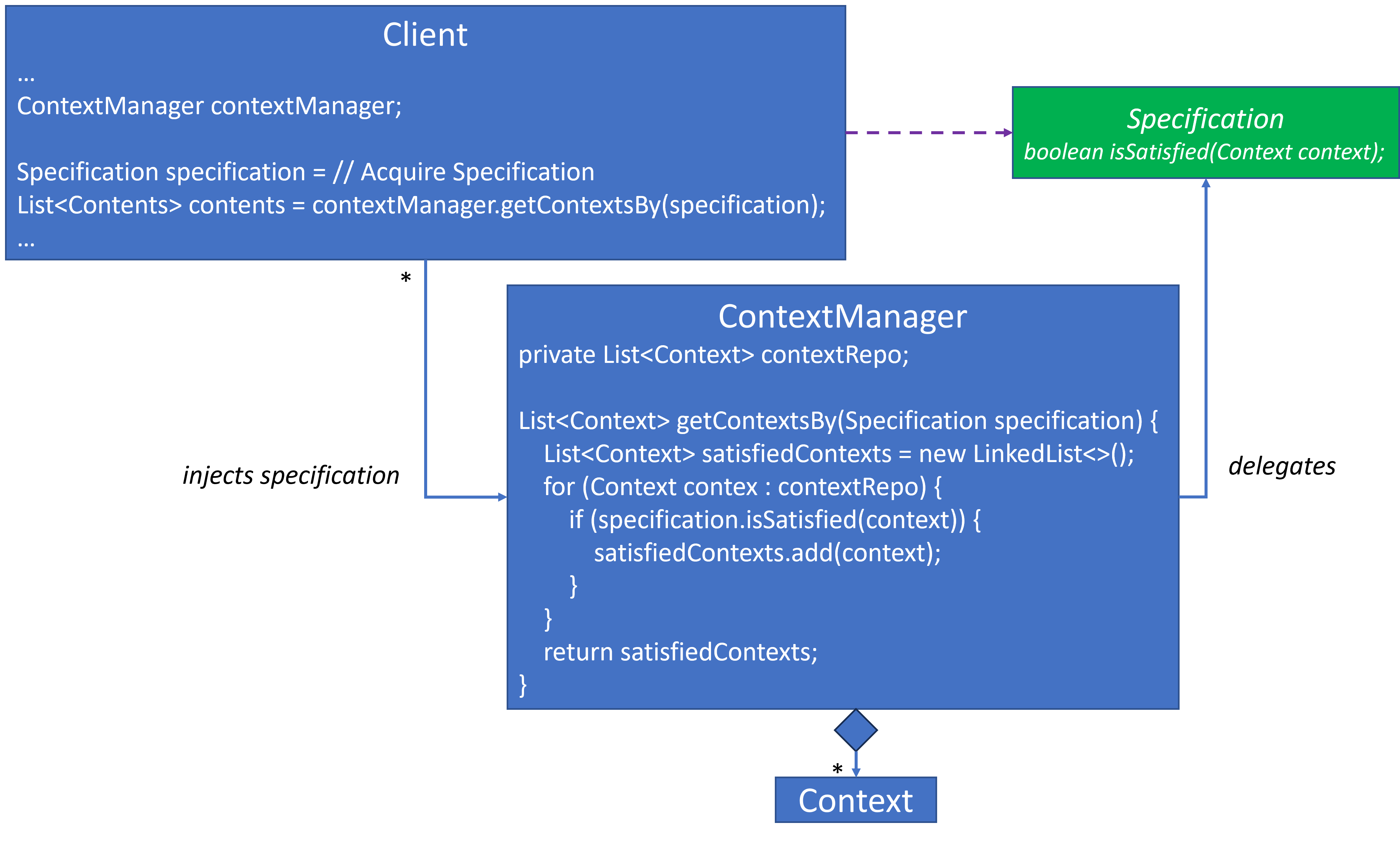
This is the last time I will show details for Client and ContextManager. It’s too much to repeat in subsequent diagrams.
Strategy
Let’s get some ideas for how we could implement Specification. Let’s start with the Strategy.
We can do quite a bit with Strategy:
- The top row of elements is the same as the previous diagram except that the implementation details have not been shown.
- This diagram has added a little more context to
Context. While only as examples,Contexthas a Color and Shape attribute. I thought this would be a bit more meaningful than AttributeA and AttributeB. - We have three
Specifications based upon these two attributes: Color and Shape. Their attributes arefinalso that theSpecificationcannot be modified after being created.
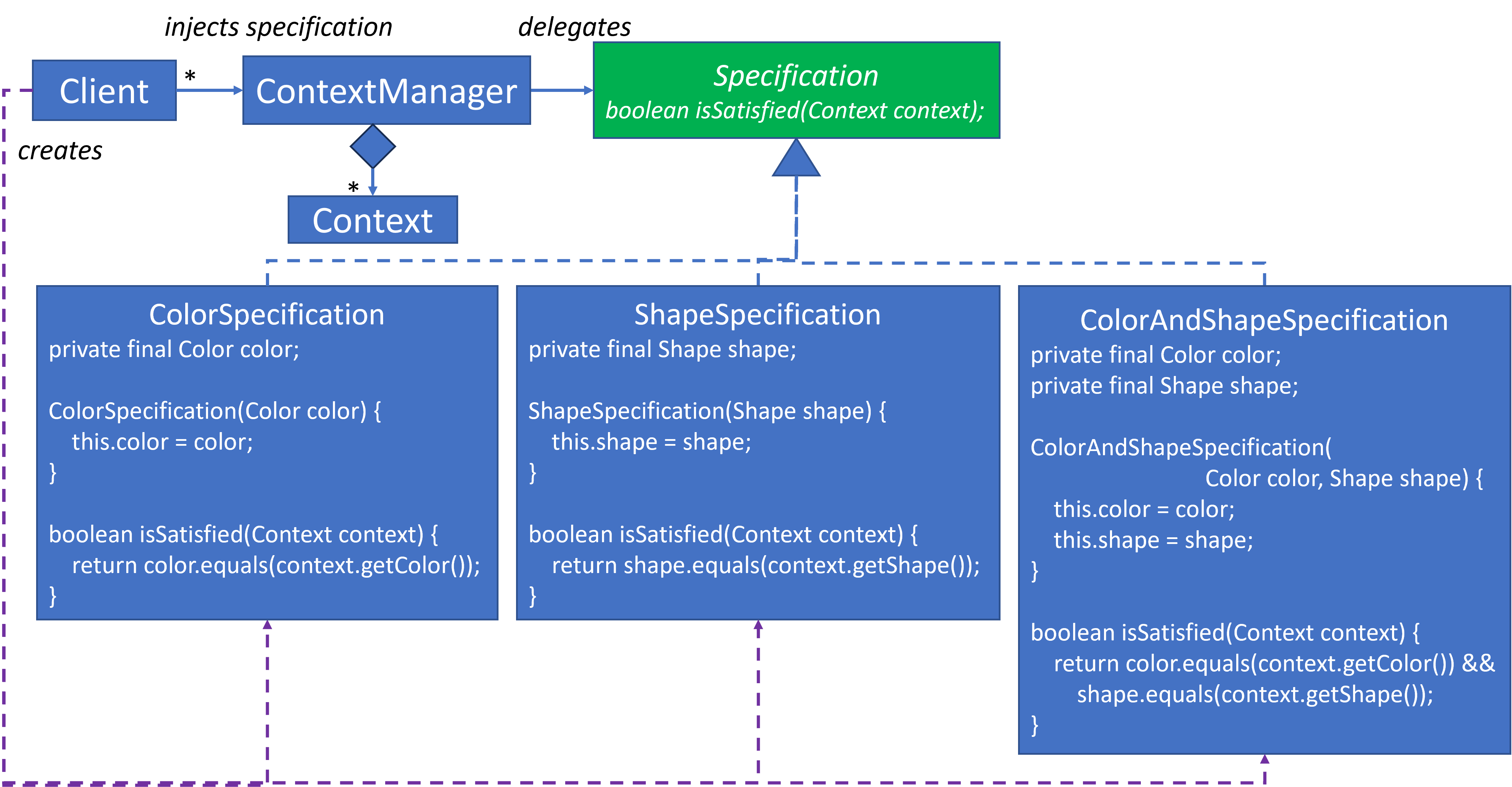
Let’s see how the Client creates Specifications. Here are some examples:
ContextManager contextManager; // injected possibly via a Configurer, not shown
...
List<Context> redContexts contextManager.getContextsBy(new ColorSpecification(Color.RED));
List<Context> circleContexts contextManager.getContextsBy(new ShapeSpecification(Shape.CIRCLE));
List<Context> blueSquareContexts contextmanager.getContextsBy(new ColorAndShapeSpecification(Color.BLUE), Shape.SQUARE));
...
Composite
Strategy will work for simple specifications with one attribute, but the ColorAndShapeSpecification is a bit of a concern. It works fine, but it’s not scalable.
What if there are multiple specifications with other attributes for Context? What about Color OR Shape? What about NOT? We don’t want to create a new Specification from scratch when we want a new combination of attributes. The number of potential combinations explodes exponentially.
This is where Composite can be useful. This design maintains the previous design, except that it removes the ColorAndShapeSpecification and replaces it with three new composable Specifications. Each of these new Specifications is a composite. These Specification composites have their own specific behavior within the context of the composite structure. Each of these Boolean operation-based composites contains other Specifications where the composite return value is based upon the return values of the Specifications they contain such that:
AndSpecification- Returns true when all its containedSpecifications return true; otherwise, false.OrSpecification- Returns true when any of its containedSpecifications returns true; otherwise, false.NotSpecification- Returns true when its single containedSpecificationreturns false, and false when it returns true.
Here is the design:
- It looks a little busy, but it’s not horrible. Consider each rectangle in isolation and its dependencies based upon its outward pointing arrows as was described in Hexagonal Architecture – Why it works. This is not a Hexagonal Architecture design, but the same dependency management benefits still apply.
- Each class has limited knowledge of the overall design. Except for the
Client, the others only have knowledge of and depend upon one or two other classes or the interface.
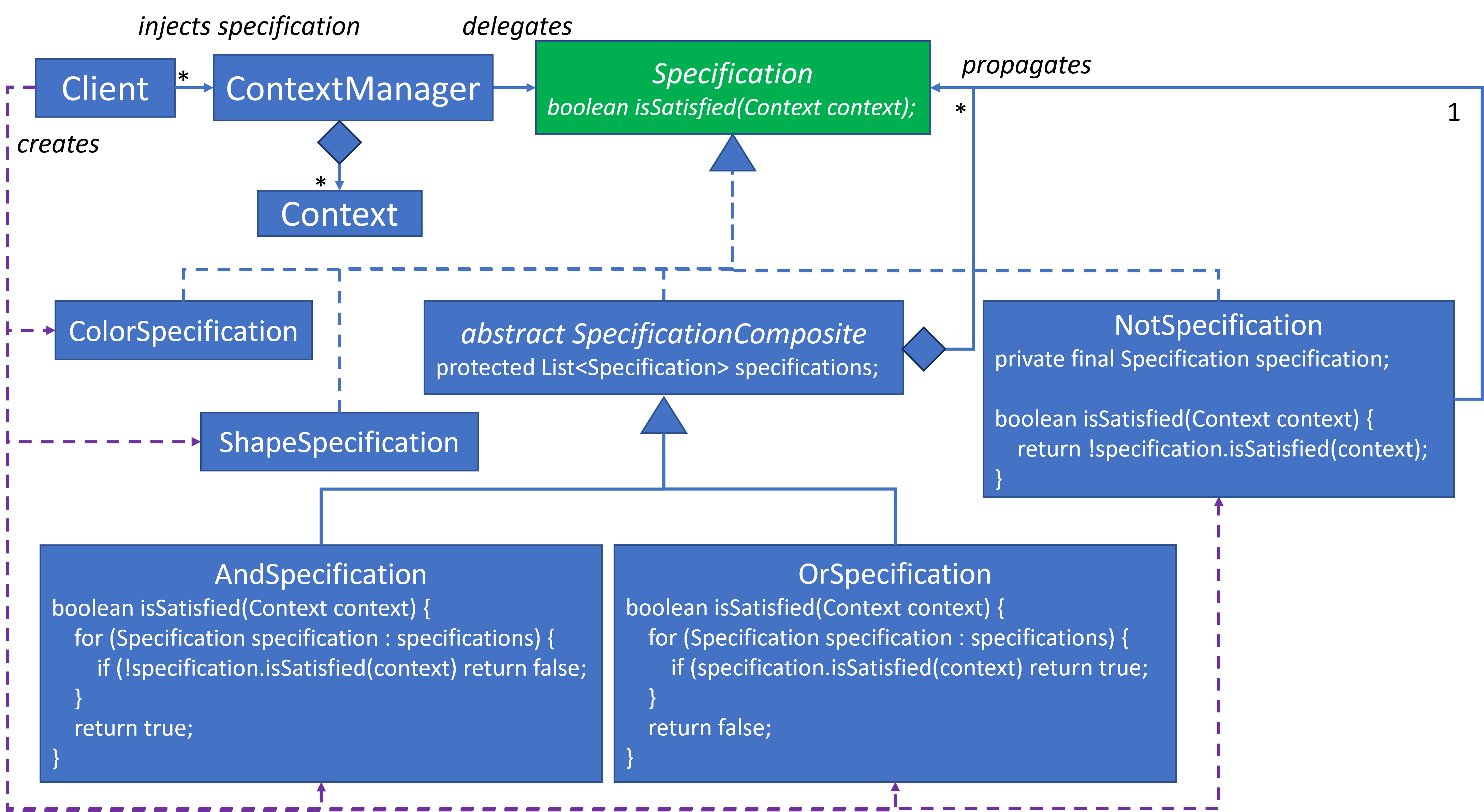
Specification Example via Composite
The previous Client Specification examples become:
ContextManager contextManager; // injected possibly via a Configurer, not shown
...
List<Context> redContexts contextManager.getContextsBy(new ColorSpecification(Color.RED)); // Unchanged
List<Context> circleContexts contextManager.getContextsBy(new ShapeSpecification(Shape.CIRCLE)); // Unchanged
Specification blueSquareSpecification = new AndSpecification();
blueSquareSpecification.add(new ColorSpecification(Color.BLUE));
blueSquareSpecification.add(new ShapeSpecification(Shape.SQUARE));
List<Context> blueSquareContexts contextmanager.getContextsBy(blueSquareSpecification); // Composed
...
Let’s examine blueSquareSpecification. It’s a BLUE ColorSpecification and a SQUARE ShapeSpecification which are then composed within an AndSpecification, such that a Context will be satisfied when it is both BLUE and SQUARE.
The AndSpecification will iterate both. If either of them returns false, then it will return false. If both return true, then it will return true.
These three Boolean composite Specifications give us almost infinite possibilities in constructing a Specification without having to add new code except when a new Specification leaf class is needed for a new other attribute.
Specification Example via Showtunes
Here’s the composite Specification for the Matchmaker as mentioned in the example above:
Matchmaker matchMaker; // injected possibly via a Configurer, not shown
...
Specification idealHusbandSpecification = new AndSpecification();
idealHusbandSpecification.add(new BuildSpecification(Slender));
idealHusbandSpecification.add(new ComplexionSpecification(Pale));
idealHusbandSpecification.add(new EducationSpecification(Scholar)); // For Papa
idealHusbandSpecification.add(new WealthSpecification(Rich)); // For Mama
Specification husbandSpecification = new OrSpecification();
husbandSpecification.add(idealHusbandSpecification);
husbandSpecification.add(new LooksSpecification(Handsome));
List<Husband> husbandCandidates matchMaker.getContextsBy(husbandSpecification);
...
The composite tree for the Matchmaker Specification would look like this:

- The class types are on the right of the colon.
- The object name is on the left of the colon.
- Anonymous objects don’t have names, so there’s nothing to the left of the colon.
- Attribute values reside under the object:class names.
- A candidate husband will be a match if he satisfies all the Slender/Pale/Scholar/Rich specifications or the single Handsome specification.
While this violates the specification order in the lyrics, one might wish to reconfigure the specification to be more efficient:
- If the Husband Candidate is Handsome, then we don’t need to check the rest of the specification. Being Slender, Pale, Rich or a Scholar is just a bonus.
- If the Husband Candidate is not Handsome, then he must be Slender, Pale, Rich, and a Scholar. It’s less likely that he’s Rich or a Scholar than Slender and Pale. Therefore, as soon as a non-Handsome and non-Rich Husband Candidate is encountered, then we can eliminate him quickly without checking the other attributes.
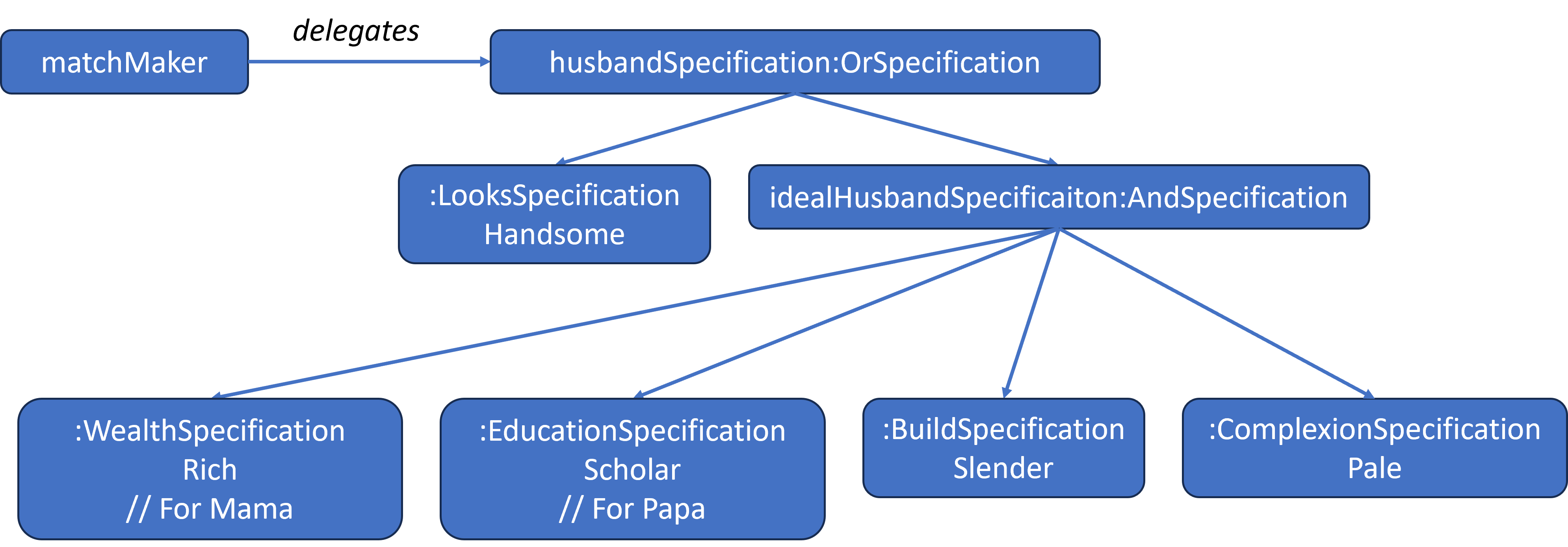
My Final Comment, Or My Comment About Final
The leaf Specification classes contain attributes such as Color or Shape. I declared them as final so that they could not be changed. Once a Specification is defined, I don’t want to worry about it being updated in such a way that it exhibits different behaviors. If a new Specification behavior is needed, then a new Specification instance should be created.
I did the same with NotSpecification. The context is slightly different, but it’s still the same intent. I don’t want the ability to change a NotSpecification instance’s behavior by changing its Specification attribute.
The leaf Specification classes and NotSpecification attributes can be declared as final and initialized in their respective constructors.
However, we can’t easily use the same constructor technique with AndSpecification and OrSpecification. If we want the ability to add Specifications individually as I showed in the previous examples, then we have to allow objects of these classes to be updated via add(Specification specification) after they’ve been constructed.
There is a way to achieve finalness with a slightly different technique. I’m going to add a simple 2-state state machine to SpecificationComposite:
- Initializing – This is the start state representing when the
SpecificationCompositeis being initialized. When in this state,add(Specification specification)can add aspecificationto thespecificationslist. - Not Initializing – This is the state representing when the
SpecificationCompositeis no longer being initialized. When in this state,add(Specification specification)will throw anInvalidStateException. There is no event transition from this state back to the Initializing state. isSatisfied(Context context)- This is the event that transitions from the Initializing state to the Not Initializing state.
Normally, I prefer a separate state machine class, but since this state machine is so simple and localized, I’m going to represent it via the isInitializing boolean attribute to keep track of the state and which actions are permitted based upon that boolean attribute state. I’m using the Template Method to keep the state machine in the common base class. AndSpecification and OrSpecification are only concerned with the satisfiability of the context with specifications. They are not concerned with the management of the specifications.
When an AndSpecification or OrSpecification is created, as many Specifications can be added to them as needed. But once they are activated with an isSatisfied(Context context) call, then they are no longer being initialized. No new Specifications can be added.
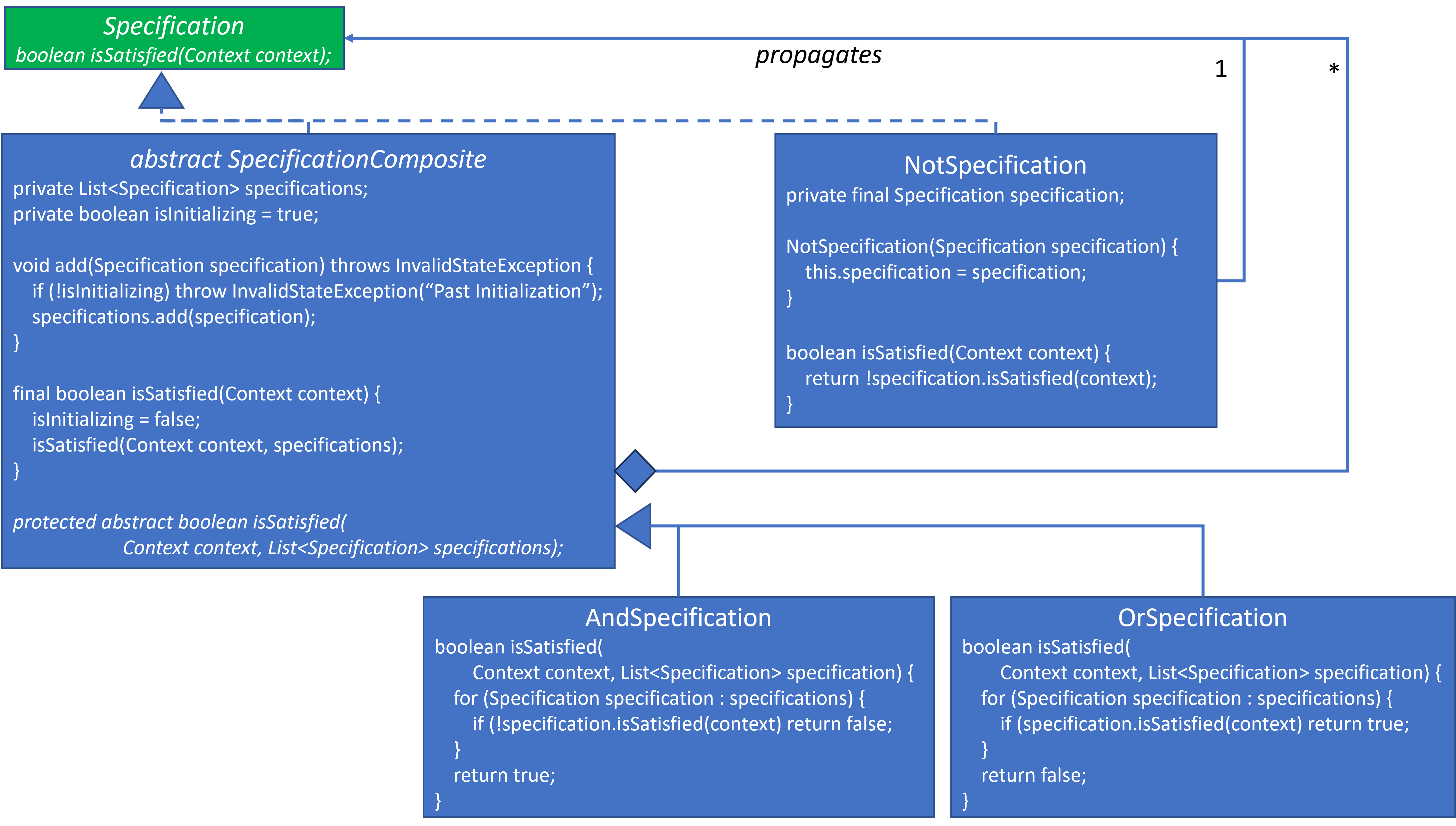
The leaf Specifications are Value Objects. Once initialized, they cannot be modified. The SpecificationComposite objects are pseudo-Value Objects. Once activated, they cannot be modified.
Leaf objects in the composite tree are immutable. The non-terminal objects will be immutable once activated. The entire composite tree is a pure function. That means that Specification, and Composite in general, are thread-safe structures. Any number of threads can be calculating satisfiability simultaneously without concern of affecting each other. State resides within the Context argument.
Use Case
This blog entry is too large to include the Use Case. It will be posted in the next blog.
Specification Pros and Cons
The relative pros and cons of Specification are like those with most of the Composable design patterns. Its flexibility is both a pro and a con.
The implementation for Specification is shockingly small. Almost the entire implementation has been shown in the code snippets above. Unit testing will also be trivial.
The power of Specification resides in giving the Client ability to design their own Specifications. Clients can construct a Specification with almost any Boolean satisfiability expression needed. It could be simple. It could be complex. When they configure a logical mistake, they’ll probably blame you first.
Summary
Specification is not in the GoF as its own concept, but it’s an extension of the Composite structure. It will tend to have more narrow uses than some of the other design patterns, but when you fall into that narrow use case, it’s good to have.
References
Since Specification is not in the GoF design pattern catalog and a bit on the margins of design patterns, there aren’t as many online resources as with other design patterns. Here are a few free resources:
- Specifications. Original article by Eric Evans and Martin Fowler
- Wikipedia Specification Design Pattern
- DevIQ Specification Pattern
- Design Pattern Specification Blog
- InfoWorld: How to use the specification design pattern in C#
- and for more, Google: Specification Design Pattern
